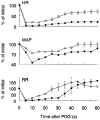Pulmonary oedema produced by scorpion venom augments a phenyldiguanide-induced reflex response in anaesthetized rats
- PMID: 10581322
- PMCID: PMC2269667
- DOI: 10.1111/j.1469-7793.1999.00537.x
Pulmonary oedema produced by scorpion venom augments a phenyldiguanide-induced reflex response in anaesthetized rats
Abstract
1. The involvement of pulmonary oedema produced by scorpion venom in augmenting a phenyldiguanide (PDG)-induced reflex response was evaluated in urethane-anaesthetized rats. 2. PDG-induced bradycardiac, hypotensive and apnoeic responses, expressed as time-response area, exhibited similarities before or after venom treatment. Hence, the time-response area of bradycardia was taken as a reflex parameter. Pulmonary oedema was determined by physical evaporation and histological methods. 3. Exposure to Indian red scorpion (Buthus tamulus, BT; i.v.) venom for 30 min increased the pulmonary water content (P < 0.05; Student's t test) and augmented the PDG-induced bradycardiac reflex response by more than 2 times (P < 0.001). The increase of pulmonary water content was maximal with 100 microg kg-1 of venom and the augmentation was maximal with 10 microg kg-1. In a separate series of experiments, the venom (100 microg kg-1)-induced pulmonary oedema was confirmed by histological and physical methods. In this group also, the venom augmented the reflex to the same magnitude. 4. Pulmonary oedema (physical and histological) and augmentation of the bradycardiac reflex response after BT venom (100 microg kg-1; i.v.) were absent in animals pretreated with aprotinin, a kallikrein-kinin inhibitor (6000 KIU; i. v.). 5. Ondansetron (10 microg kg-1; i.v.), a 5-HT3 receptor antagonist, failed to block the venom-induced pulmonary oedema (physical and histological) but blocked the venom-induced augmentation of the reflex. 6. The results of this study indicate that the venom-induced augmentation of the PDG reflex is associated with pulmonary oedema involving kinins utilizing 5-HT3 receptors.
Figures






Similar articles
-
Indian red scorpion (Buthus tamulus) venom-induced augmentation of cardiac reflexes is mediated through the involvement of peripheral 5-HT3 and central 5-HT1A receptor subtypes.Toxicon. 1999 Dec;37(12):1697-709. doi: 10.1016/s0041-0101(99)00112-9. Toxicon. 1999. PMID: 10519648
-
B(2) kinin receptors mediate the Indian red scorpion venom-induced augmentation of visceral reflexes via the nitric oxide cyclic guanosine monophosphate pathway.Acta Physiol (Oxf). 2009 Aug;196(4):365-73. doi: 10.1111/j.1748-1716.2008.01953.x. Epub 2008 Dec 25. Acta Physiol (Oxf). 2009. PMID: 19133874
-
Indian red scorpion (Buthus tamulus) venom-induced augmentation of cardiac reflexes is mediated through the mechanisms involving kinins in urethane anaesthetized rats.Toxicon. 1998 Feb;36(2):309-20. doi: 10.1016/s0041-0101(97)00121-9. Toxicon. 1998. PMID: 9620578
-
Mechanisms underlying the augmentation of phenylbiguanide and capsaicin induced cardiorespiratory reflexes by Mesobuthus tamulus venom.Pulm Pharmacol Ther. 2012 Oct;25(5):383-91. doi: 10.1016/j.pupt.2012.07.001. Epub 2012 Jul 20. Pulm Pharmacol Ther. 2012. PMID: 22820164
-
Involvement of phospholipase A2 pathway for the Indian red scorpion venom-induced augmentation of cardiopulmonary reflexes elicited by phenyldiguanide.Neurosci Lett. 2008 Aug 8;440(3):242-5. doi: 10.1016/j.neulet.2008.05.088. Epub 2008 Jun 19. Neurosci Lett. 2008. PMID: 18571849
Cited by
-
B1-kinin receptors modulate Mesobuthus tamulus venom-induced vasosensory reflex responses in anesthetized rats.Indian J Pharmacol. 2016 Jul-Aug;48(4):388-393. doi: 10.4103/0253-7613.186202. Indian J Pharmacol. 2016. PMID: 27756949 Free PMC article.
-
Venom effects on monoaminergic systems.J Comp Physiol A Neuroethol Sens Neural Behav Physiol. 2004 Sep;190(9):683-90. doi: 10.1007/s00359-004-0526-3. Epub 2004 May 25. J Comp Physiol A Neuroethol Sens Neural Behav Physiol. 2004. PMID: 15160282 Review.
-
A study to investigate capsaicin-induced pressure response in vagotomized rats.Indian J Pharmacol. 2013 Jul-Aug;45(4):365-70. doi: 10.4103/0253-7613.115019. Indian J Pharmacol. 2013. PMID: 24014912 Free PMC article.
-
Involvement of Kallikrein-Kinin System on Cardiopulmonary Alterations and Inflammatory Response Induced by Purified Aah I Toxin from Scorpion Venom.Inflammation. 2016 Feb;39(1):290-302. doi: 10.1007/s10753-015-0249-3. Inflammation. 2016. PMID: 26361946
-
Morphine blocks the Mesobuthus tamulus venom-induced augmentation of phenyldiguanide reflex and pulmonary edema in anesthetized rats.Indian J Pharmacol. 2016 Jan-Feb;48(1):74-7. doi: 10.4103/0253-7613.174560. Indian J Pharmacol. 2016. PMID: 26997727 Free PMC article.
References
-
- Anand A, Paintal AS. Possible role of capillary permeability in excitation of sensory receptors by chemical substances. Progress in Brain Research. 1988;74:337–340. - PubMed
-
- Babe KS, Serafin WE. Histamine, bradykinin and their antagonists. In: Hardman JG, Limbird LE, editors. Goodman and Gilman's Pharmacological Basis of Therapeutics. New York: MacGraw Hill; 1996. pp. 581–600.
-
- Bagchi S, Deshpande SB. Indian red scorpion (Buthus tamulus) venom-induced augmentation of cardiac reflexes is mediated through the mechanisms involving kinins in urethane anaesthetized rats. Toxicon. 1998;36:309–320. - PubMed
-
- Bagchi S, Deshpande SB. Indian red scorpion (Buthus tamulus) venom-induced augmentation of cardiac reflexes is mediated through the involvement of peripheral 5-HT3 and central 5-HT1A receptor subtypes. Toxicon. 1999;37:1697–1709. - PubMed
-
- Coleridge HM, Coleridge JCG. Impulse activity in afferent vagal C-fibres with endings in the intrapulmonary airways of dogs. Respiration Physiology. 1977;29:125–142. - PubMed
Publication types
MeSH terms
Substances
LinkOut - more resources
Full Text Sources

